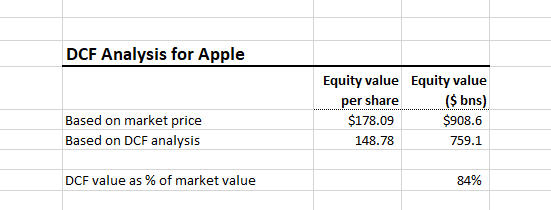Introduction
The value of an investment can be calculated by discounting the expected future cash flows (or DCF). The value of an investment can be determined using DCF by factoring in expected future returns. In addition to asset purchases, DCF analysis can evaluate investments. In the case of privately held enterprises, DCF can be utilized as a valuation approach. Discounts for the passage of time are applied to a projected stream of future cash flows or earnings. Since today's dollar can be invested to earn more money in the future, the time value of money states that today's dollar is worth more than tomorrow's dollar.
How Does The Discounted Cash Flow Model Work?
The discounted cash flow model has based on the fundamental tenet that a company's value equals the sum of its expected future cash inflows discounted to the present. The concept of present value is where we should begin. Money today is regarded as worth more than an identical amount of money at some point in the future because it can be invested to generate returns and because the dollar value decreases typically gradually over time due to inflation. In general, the further away in time the transaction is, the more significant the discount or lower the value of the money.

How to Build a DCF Model
Future cash flows are the sole determinant of a company's value, according to the DCF model's concept. Therefore, defining and quantifying a business's cash flows is the primary difficulty in constructing a DCF model. The cash flows of a company can be determined in two different ways.
Unlevered DCF approach
Estimate the operating cash flows and their discount rates. Then, to arrive at a present value, you would add any cash or other non-operating assets and deduct any debt or financing liabilities.
Levered DCF approach
In other words, you need to project and discount the cash flows available to equity shareholders once all other claims (such as debt) have been satisfied.
An Acid Test for Valuing a Public Stock
The discounted cash flow (DCF) method is the gold standard for valuing privately owned enterprises and the litmus test for publicly listed stocks. The market P/E ratio for a publicly traded US company may be higher than the discounted cash flow estimate. This is especially true for newer, smaller businesses with high capital requirements and erratic or unpredictable revenue and cash flow. However, sky-high P/E ratios do not always indicate a scam, especially for large, profitable corporations.
The DCF Model Formula
There are simpler models, such as the dividend discount model, but the DCF formula is more involved. Here's the formula:
The present worth formula is: [CF1 / (1+k)]. + [CF2 / (1+k)2] TCF * (k-g) * (1+k)n-1
Cash Flow Forecast Year 1 (CF1), Cash Flow Forecast Year 2 (CF2), Terminating Cash Flow; Total Cash Flow Expectation. Since predicting more than five years into the future is a guessing game, this is typically an estimate. In finance, this figure is referred to as the "discount rate" or "required rate of return." For each year in the model, g represents the anticipated growth rate, and n is the total number of years. However, there is a more straightforward method to view this. For this example, let's pretend that Dinosaurs Unlimited is a modest, made-up business. Let's pretend we're making a five-year projection with a discount rate of 10%, a growth rate of 5%, and no inflation.
Build Your Estimate Of The Future
Many businesses provide projections for future growth rates on their investor relations websites. For others, Wall Street analysts will provide public estimates of future growth. Others will be more reserved about their prospects but have successfully established themselves enough to offer some insight. Consider that the company's long-term prospects are probably distributed along an S curve, regardless of your projection source. To put it another way, if you're trying to predict its future growth using models, you should factor in a gradual slowing of its growth rate.

Conclusion
The value of an investment can be calculated using the discounted cash flow (DCF) method, which factors in the investment's expected return and the cash flows that are expected to be generated by the investment in the future. In most cases, the weighted average cost of capital (WACC) is employed as a barrier to entry, indicating that the expected rate of return on the investment must be higher than the WACC. The discounted cash flow (DCF) model is the gold standard for valuing privately owned companies, but it may also be used as a sanity check on publicly listed stocks.




